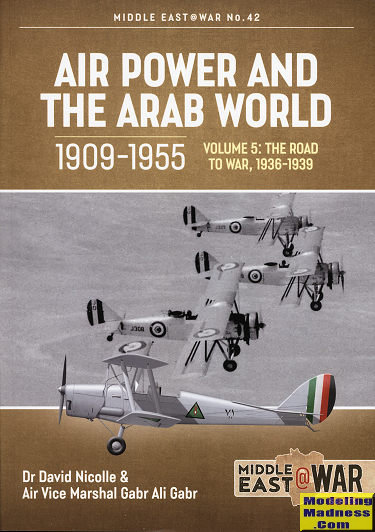 This is the
fifth volume in a series of books covering the use of aircraft in various
countries in North Africa and the Middle East between 1909 and 1955. This one
covers basically two air arms, that of Iraq and that of Egypt, arguably the two
most modern forces in this region in the years immediately before the start of
WWII in Europe.
This is the
fifth volume in a series of books covering the use of aircraft in various
countries in North Africa and the Middle East between 1909 and 1955. This one
covers basically two air arms, that of Iraq and that of Egypt, arguably the two
most modern forces in this region in the years immediately before the start of
WWII in Europe.
Iraq was a nation in constant turmoil (sound familiar?).
Changes in government in the late 30s were fairly frequent and the military was
often involved. Iraq initially got their aircraft from the UK, but there were
tensions between the two nations as there were still a fair number of British in
the country and for the most part, they were not wanted. During this period, the
British turned over several bases to the Iraqis, but not all of them. It was
during this period that Iraq turned to Italy for its aircraft. This resulted in
the purchase of several offensive types including SM.79 bombers and Breda Ba.65
attack aircraft. These planes gave Iraq a fairly potent offensive force for the
region. It also made the British fairly nervous.
Meanwhile in Egypt, much of the same scenario was taking
place. The Egyptians, for the most part, did not want the British in their
country, but needed them to help run the military until enough officers reached
a high enough rank to take over. While the Army was in a pretty good position by
the late 30s, the same could not be said for the Air Force which hadn't been
around for too many years. They relied on not only British equipment, but also
men to help train pilots and ground crews. Eventually the situation got better
as time went on, including a number of more modern (but still not the most
modern) aircraft and a greater number of pilots. As with Iraq, the Egyptians
often had more aircraft than pilots and found that getting spares was not the
easiest thing. Still, the looming Second World War resulted in a fairly large
influx of equipment just prior to the start as the British were paranoid about
protecting the Suez Canal and being 'surrounded' by Italians.
Typical of everything military, and especially in this
part of the world, politics played a fairly major role in the scheme of things.
There were often times when less capable but more politically connected people
were put in places of seniority until their lack of competence forced them out.
Also the officer corps of both nations tended to be a lot more political,
something that, at times, caused issues.
The authors of this series have very much done their
homework in regards to these two air arms. We can get a look at not only the
equipment and men who flew the planes, but also the politics behind the choices
as well as the way the two services were run. When you add in some superb period
photos, a fair number of color profiles and the smooth flowing prose, it makes
for a nice addition to what is becoming a great series. Very much worth picking
up.
February 2022
Copyright ModelingMadness.com. All rights reserved. No
reproduction in part or in whole without express permission.
Review book courtesy of
Casemate Publishing, where you can order your copy
at this
link.
If you would like your product reviewed fairly and
fairly quickly, please
contact
the editor or see other details in the
Note to
Contributors.
 This is the
fifth volume in a series of books covering the use of aircraft in various
countries in North Africa and the Middle East between 1909 and 1955. This one
covers basically two air arms, that of Iraq and that of Egypt, arguably the two
most modern forces in this region in the years immediately before the start of
WWII in Europe.
This is the
fifth volume in a series of books covering the use of aircraft in various
countries in North Africa and the Middle East between 1909 and 1955. This one
covers basically two air arms, that of Iraq and that of Egypt, arguably the two
most modern forces in this region in the years immediately before the start of
WWII in Europe.